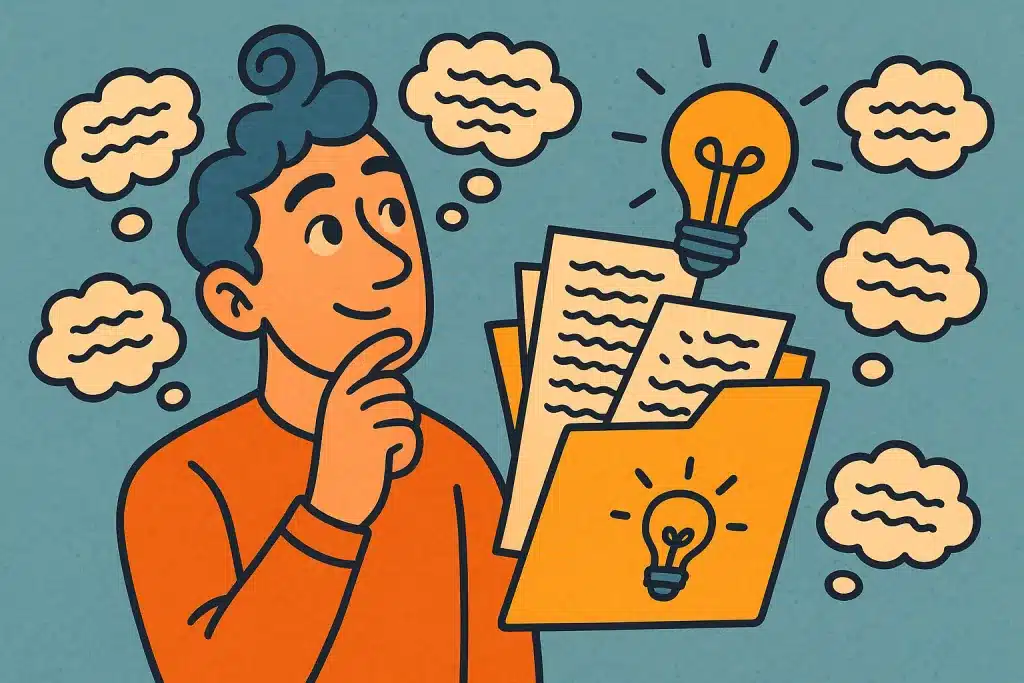Curious about What Makes a Thought Worth Keeping? You’re not alone. In today’s digital era, cognitive scientists and technologists are exploring how we decide which thoughts to retain—or discard—and how trends like AI, memory hacks, and embodied cognition shape that process.

Key Trends Shaping the Value of a Thought
1. Cognitive Off‑loading & AI Dependency
Modern tools—from search engines to chatbots—allow us to off-load mental tasks. According to recent research, frequent usage of AI tools is linked to a decline in critical thinking, mediated by cognitive off-loading. In one study, greater reliance on AI tools had a significant negative correlation with critical thinking skills (r ≈ –0.68), and cognitive off‑loading itself mediated this effect (b ≈ –0.25, p < 0.001) .
This trend calls into question What Makes a Thought Worth Keeping? as we place more faith in external systems. Thoughts that cultivate independent reasoning—rather than mere retrieval—become more valuable in this context.
2. Memory Science: Testing and Mental Recall
Educational psychology has long recognized the testing effect: retrieving information improves long‑term memory retention far better than passive review . Similarly, the forward testing effect—embedding tests within lectures or study sessions—helps reduce mind-wandering and boosts new learning .
But the newest development is the “mental time travel” technique. A PNAS study with over 1,200 participants found that recalling emotions and thoughts linked to memory encoding could rejuvenate fading memories: restoring up to 70–84% recall after a few hours, though fading over a week .
These findings suggest that a thought’s worth lies in whether it can be actively recalled or refreshed. That answer helps define What Makes a Thought Worth Keeping?
3. Context & Embodied Cognition
Memory isn’t stored in isolation. Context-dependent memory shows that retrieval improves when context is matched, even during sleep (through targeted memory reactivation) .
Meanwhile, embodied cognition emphasizes that bodily movement and sensory experience support thought retention. Gestures, physical interaction, and sensorimotor cues enhance memory encoding and retention across learning domains—laying a foundation for deciding which thoughts stick .
Hence, a thought tied to physical or emotional context feels more memorable—and more worth preserving.
Why Some Thoughts Are Worth Keeping—and Others Are Not
Meaningful, Novel, Emotionally Rich Thoughts
Emotions help anchor memory. According to mental time travel research, reactivating emotional associations restores memory strength. Thoughts linked to novelty or personal significance are more resistant to forgetting.
Actively Retrieved Thoughts
According to the testing effect and forward testing research, thoughts frequently recalled—either self‑generated or prompted—are more likely to endure. That means active engagement with a thought confirms its lasting value.
Context‑Anchored Thoughts
When a thought is tied to a rich context—physical, situational, or emotional—it has a scaffold to support memory. This is the heart of embodied and context‑dependent cognition.
Disposable or Replaced by Tools
Automatic or tool-dependent thoughts—such as frequently Googled facts—lack the mental investment that retains them. Over-reliance on digital tools may reduce the intrinsic worth of retaining such thoughts.
Practical Guide: Cultivating Thoughts That Stick
Here’s how you can decide and act on What Makes a Thought Worth Keepin1. Practice Retrieval and Testing
- Use spaced recall: quiz yourself after learning.
- Self‑test through flashcards or recitation.
- Interleave review with quizzes to build resilience .
2. Tie Thoughts to Context or Physical Activity
- Use gestures to illustrate concepts—as embodied learning studies show improves memory retention .
- Recreate study locations or environments associated with thoughts.
- Employ sensory cues (music, scents) during learning to serve as retrieval anchors.
3. Emotionally Engage With the Thought
- Write briefly about what the thought means to you.
- Recall the emotional state when originally encountering the idea (mental time travel).
- Use vivid storytelling or imagery to reinforce emotional tags.
4. Reflect Critically, Don’t Just Off‑load
- Question AI-generated answers; engage in analytical thinking.
- When using tools, challenge their output with your own reasoning.
- Make note of ideas in your own words rather than copying verbatim.
5. Use Digital Tools Intentionally
- Treat AI and search as scaffolds—not substitutes—for memory.
- Use flashcard apps, spaced-repetition systems, or cognitive journaling tools as active memory aids.
- Maintain a digital archive of insights but prioritize manual summaries and reflection.
Emerging Trends to Watch
AI That Aids Recall Without Replacing Thinking
The next wave of tools aims to integrate AI suggestions while prompting users to critically reflect and retrieve information themselves—balancing convenience with engagement.
Virtual Reality (VR) for Context‑Based Thought Retention
VR environments can replicate or create contexts to treat embedded thoughts as part of sensorimotor memory—e.g., walking through a virtual lab or landscape tied to concepts.
Neuroscience Tuned Interventions
Advanced methods like targeted memory reactivation during sleep (via cues like sounds) may support consolidation of thoughts deemed valuable .
Investors and educators alike are watching these shifts closely to understand What Makes a Thought Worth Keeping?
Conclusion: The Future of Thought Selection
In an age where external tools like AI and digital archives can store and retrieve information effortlessly, deciding What Makes a Thought Worth Keeping? becomes a deeply intentional act. Thoughts that endure are those rooted in emotional meaning, reinforced through active recall, and tied to physical or contextual cues that make them vivid. Conversely, trivial thoughts, disconnected from context or easily outsourced to technology, often fade unless deliberately curated. As neuroscience and technology refine how we select and retain memories, a thought’s worth isn’t inherent—it’s earned through the meaning and effort we assign to it. The future of thought selection lies in balancing technology’s power with the human choice to prioritize what truly matters.
References
S. A. Christianson & E. L. Loftus, “Emotion and Memory: how emotional arousal influences retention and recall,” Trends in Cognitive Sciences (via Emotion and memory) (2025).
en.wikipedia.org.
Timothy B. Rogers, Nicholas A. Kuiper & W. S. Kirker, “Self‑Reference and the Encoding of Personal Information,” Journal of Personality and Social Psychology (2025).
en.wikipedia.org.
Mike Troxell, “How Much Is a Memory Worth?”, miketroxell.com (2025).miketroxell.com.






